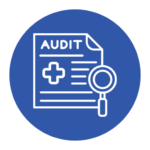Revenue Cycle Management Challenges for Healthcare Providers
Introduction
Due to innovation in technology today, revenue cycle management (RCM) poses significant problems to medical facilities. Accounts receivables, claims, and payments management and revenue generation all qualify under RCM. It is very significant for healthcare providers to understand these challenges as they search for ways to increase their source of revenue and financial stability. To help overcome these challenges, Med Revolve Billing is presenting a basic approach.
What is Revenue Cycle Management?
In healthcare organizations they use what is known as revenue cycle management, or RCM to manage the payment and the claim processing of patient accounts. It becomes crucial for healthcare providers to comprehend the problem they encounter in improving their revenues cycle.
It I important to define what exactly is meant by Revenue Cycle Management before going to look at what challenges it presents. Hired care provider cycle commences from the time a patient makes an appointment to the moment the provider receives full payment for the rendered service or care. To understand the stages that money goes through in healthcare, there are five of them, namely; registration of charges, capture of charges, submission of claims, posting of payments and payment denial.
Key Challenges in Revenue Cycle Management
1.Increasing Healthcare Costs:
Some of the reasons include: medical technology, the increase aging population, and the increase in severe diseases. This places pressure on healthcare providers to generate more cash on the other hand providing quality service delivery. This therefore presents a challenge to the providers, who must look for ways of cutting costs while giving patients a worthy service.
Complex Billing Process:
Billing in the healthcare sector is quite a process and includes use of different codes for instance CPT, ICD-10 and HCPCS rules and regulation. This could precede errors and denials of claim since every insurance payer has its own guidelines which must be followed. Healthcare institutions have to ensure they adopt the modern coding standards that exist to minimise the rejections of their claims.
2.Insurance Verification:
Validation of insurance coverage and patient’s insurance benefits is one among the critical steps in overall revenue cycle management. But it is clumsy and may take a lot of time, and it can even be prone to errors. Necessary insurance data check may be flawed, causing rejected claims and delayed payments. Administrators and practitioners in health care facilities require proper means and methods of insurance authentication to minimize on the number of errors.
3.Claims Denials:
An issue about claims rejected since they had not met the required standard and to avoid payments to the health care providers, there are losses in terms of revenue as well as high costs of administration. The common reasons for claims denial include coding mistakes, lack of adequate documentation, and non-reimbursable services among others Health care providers should also feature a proper denial management plan in order to analyze, appeal or prevent future claim denials.

4.Patient Collections:
It is often difficult to receive money from the patients through insurance, simply because, with the introduction and use of the HDHPs patients are fully responsible for their bills. Since most consumers experience difficulty in making payments for their medical expenses, these present situations have open balances with possibilities for bad debt on the side of the healthcare providers. The providers should focus more on informing the patients on the forms of collection while at the same time giving them a broad range of UoM during repayment.
5.Regulatory Compliance:
There are many laws on health care, but the standard of Medicare requirement for compliance and HIPAA are a few of them. As will be seen below, failure to adhere to them may lead to fines, which could lead to penalties, loss of reputation, among other outcomes. Thus, providers do not spend a lot of money on training and other resources needed to meet the regulations but instead they pay hefty fines
6.Technology Integration:
The implementation of other IT solutions like HER and billing are complex and kostly processes. However, they have challenges regarding connectivity, transferring data and training of personnel when they integrate new technology. However, the manner in which we employ computers in the processing could go a long way towards enhancing processes as well as the extent of the revenue cycle.
7.Staff Training:
This requires that staff is always updated on the existing regulations, coding guidelines as well as the best practice in billing and coding to meet the ever – changing regulations of revenue cycles. In this case, ongoing training and development can make certain that employees are aware of the things that they are meant to do, thereby preventing avoidable mistakes in order to enhance revenue collection.
8.Data Security:
In the health care sector, both or patients security and privacy can play essential roles. The increase in cyberattacks on networks makes healthcare providers respond to improved security of patients’ data when implementing solutions for a strong network. Lack of data protection may result in loses, negative impact a company’s reputation or fines by the authorities.
9.Revenue Leakage:
For health care providers, I have established that it is always a challenging exercise tosearch or identify where money goes or is not accounted for. This may include under coding of services rendered, improper codes on the claim forms; and bad policies for billing. The suggested actions include: conducting periodic audits and using steps to minimize revenue loss while maximizing revenue capture for providers.
In sum, the healthcare providers experience many rends in the management of revenue cycle. It is therefore important for the providers to understand these barriers in order to institute measures that will enhance their income plus financial sustainability.

Med Revolve Billing Has Key Strategies to Overcome Revenue Cycle Management Challenges
1.Automating Processes:
There are many areas such as automatic billing, claims processing and payment collection that, when automated, can lead to far better results as compared to manual handling. The use of automated systems in health care facility could enhance work flow, increase efficiency and eliminarate recurrent errors that might occur in billing and claims process.
Staff Training and Education:
Fresh coding training, billing and compliance training of the employees is very helpful and can be carried out continuously to avoid more mistakes and enhance more revenues. Required trainings are also effective free tools that can enable staff to enhance their familiarity with the new and existing regulations and skillfulness on the management of revenue cycle.
Improving Patient Communication:
Fundamental goals that need to be met in the bid to enhance collections include explaining to patients their contribution and payment plans. It is important to minimize confusion about billing to patients, and offering proper comprehensible documentation simplifies this process.
Outsourcing RCM:
The analysis shows that outsourcing of the revenue cycle management to a third-party vendor can save costs of healthcare providers and increase their efficiency. Outsourcing is one of the opportunities to obtain access to the specialist knowledge and technologies. This leads to better revenues cycle performance.
Utilizing Data Analytics:
Applying the big data methods to analyze various RCM related patterns and patterns can assist providers in improving their RCM. Business intelligence reveals opportunities for improving efficiency, enabling the company to secure more business.
Streamlining Processes:
You can improve the submission of claims for payment and the posting of payments to save time and minimize mistakes. Policy makers and providers should also enhance the performance by improving the organization structure to reduce unnecessary procedures as well as freer and smoother communication methods.
Regular Audits:
Performing routine samples of several revenue cycle activities can enable locations to fix or prevent problems that can develop. The audit allows providers to identify gaps that need sealing and to minimize mistakes and obligations they must meet.
Collaboration Between Departments:
More efficient collaboration of billing, coding and clinical departments contributes to optimization of the revenue cycle. This partly explains why collaborative working can lead to early detection and efficient handling of problems ailing the company’s revenue cycle performance.
Patient Financial Counseling:
Discussed general ways of rendering financial counseling/assistance pertaining to medical collections to patients in order to enhance collections and quality patient satisfaction. Financial consultation is important because it helps the patient comprehend their obligations and the forms of payment acceptable. This results in improved collection of the receivables and shrinkage of the bad debt portfolio.
Implementing Revenue Cycle Management Software:
Application of special software programs for flow of revenue management can be useful in automatizing the processes. The use of revenue cycle management helps the providers manage the billing, claim and payment collection.
Conclusion
Unpuzzling the dilemmas of the healthcare revenue cycle is important to healthcare providers and organizations. Major challenges include Staffing problems, process inefficiencies, patient communication issues, ICT integration and system upgrades From these challenges, healthcare institutions can use methods like automation of process, staff training and enhancing of patient communication to minimize the challenges. Med Revolve Billing is very expert in resolving these challenge.
Engage and Explore
How Med Revolve Billing can increase your revenue and optimize your RCM







